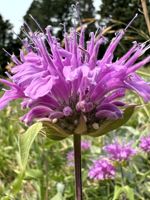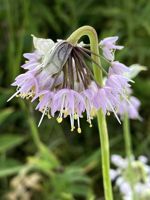Mon-Fri 9am - 5pm Mountain time
Wild Bergamot vs Nodding Onion
Monarda fistulosa
Allium cernuum
NOT AVAILABLE THIS SEASON - MIGHT RETURN
NOT AVAILABLE THIS SEASON - MIGHT RETURN
Wild Bergamot is a native perennial wildflower that is known for its fragrant lilac-purple tubular flowers. The flowers grow in dense terminal heads and bloom from mid-summer to early fall. Deadheading spent flowers will encourage new blooms, prolonging its display. They attract pollinators such as bees, butterflies, and hummingbirds. It also serves as a host plant for the Raspberry Pyrausta (Pyrausta signatalis) butterfly.
Wild Bergamot belongs to the mint family, and its leaves, stems, and flowers are all edible. The leaves can be used to make tea or as a flavorful herb, with a taste often described as a blend of oregano and thyme.
It is resistant to deer and rabbits but can be susceptible to powdery mildew if planted too densely with poor air circulation. Wild Bergamot tolerates heat, drought, and poor soils, making it a low-maintenance addition to a variety of projects. It is well suited for pollinator gardens, wildflower gardens and naturalization projects.
Nodding Onion is a native perennial wildflower known for its nodding clusters of flowers that range in color from white to pink to purple. The lightly scented blooms provide pollen and nectar for pollinators, especially bees, which can collect while hanging upside down, a capability most other insects lack.
The narrow, grass-like leaves of the Nodding Onion can be used as a seasoning in cooked dishes, though bulbs and raw leaves should not be eaten in large quantities. All parts of the plant have an onion-like aroma when bruised, which helps deter deer and rabbits. They can self-seed readily, so removing spent blooms helps manage their spread. Tolerant of a range of soils, including alkaline, it is well-suited for a variety of plantings, including pollinator gardens and naturalization projects.
Wild Bergamot Quick Facts
Nodding Onion Quick Facts
Toxicity: raw leaves and bulbs can be midly toxic

